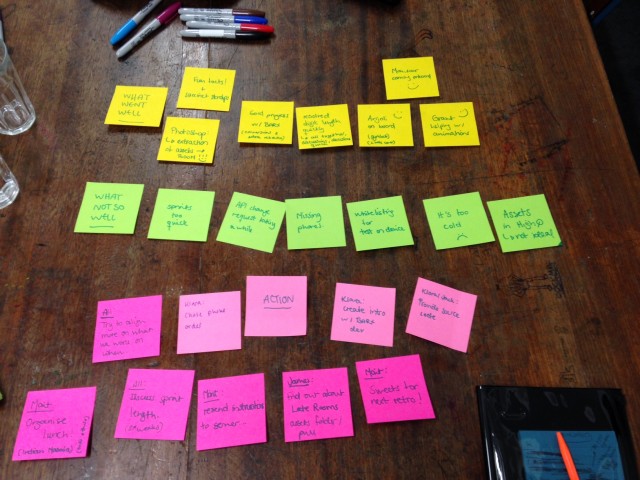Building digital products takes a wide variety of skills and mindsets. Sometimes these skills need to be distributed, and this can have its challenges.
Over the past year, I’ve worked with a team of ten very different, strong personalities based across four locations and two time zones.
We worked in Scrum and over time it became surprisingly smooth. We improved week by week – failing, learning and trying new ways of communicating whilst working together.
Here are six important things I’ve learned whilst building a happy, distributed team.

1 – Deal with it
Let’s face it, working 'distributed' can sometimes be frustrating. Things can take longer. Tools don't always do what you want, connections aren't always slick and differing time zones definitely don't make life any easier.
That being said, we’re making it work because we need and want to. We fail, learn and develop through retrospection. No matter how good a sprint we've had, there's always room to improve. At the end of every sprint, we make sure collectively to capture our 'goods' and 'bads', and discuss how we'll act upon them next time.
2 – Change it up
Remote meetings can be a challenge – it’s harder to stay engaged and focused, and they need careful thought to make sure they work properly.
A daily standup is a well-known procedure for most teams working Agile, and with good reason. The traditional standup consists of three elements: “What did I accomplish yesterday?”, “What will I focus on today?” and “What is blocking my progress?” It’s short, direct and gives a good sense of clarity amongst the team.
Standups work best when you, funnily enough, stand up – so it’s no surprise the traditional way can be hard through a conference call. As the team grows, it’s hard to keep group focus during the daily standup and for the individual to focus on the delivery goal of the user story.
Six months into the project, we changed our daily standup and began 'walking the board' during these sessions. This meant we'd go through the user stories in progress from top to bottom of the related tasks. This gives a wider picture of the sprint, instead of team members just talking around their own tasks.
Try out new ways to explore and challenge already established habits. Slight adaptions to old methods can make marked improvements on team communication.
3 – Be transparent
Transparency is the most important thing when working remotely. Sharing screens of work in progress, ideas and thoughts can be very helpful. Developers – share your screenshots. Designers – share your sketches and high-level design directions to ensure everyone is aligned and has a say. There are plenty of excellent tools for this – Screenhero and chat apps such as Slack and Google Hangout can make for seamless communication.
4 – Create together
Every time we introduce a new feature or design change, the whole team is involved – not only when fleshing out the concept, but all the way through implementation and testing.
Sketching things together is a key part of creating a transparent and trusting work environment. It allows various perspectives and insights from all areas of the team. It creates a lot of ideas – early and fast – encouraging a culture that encourages honest and open feedback. It's more difficult to do remotely, but that's the reason it's so important that you try.
We start by going through the acceptance criteria together, making it clear for the whole team what we’re trying to accomplish and why. Then we allow 5-7 minutes for everyone to sketch individually before sharing ideas with the rest of the team, this exercise is often repeated 2-3 times. Brief. Sketch. Share. Repeat. The design team then take the sketches and flesh out a design flow so the developers can get started whilst visual design is being explored.
5 – Invest in culture
Team culture is much more than a foosball table and a Friday beer. Culture is a safe environment in which everyone can be themselves, ask questions, make mistakes and grow. It takes work to create culture within a remote team, but it’s definitely doable.
Get the team together as often as possible, but most importantly at kick-off and when celebrating a success. For the product team this is key, we’ve physically gathered a couple of times during the year and every meeting has given a sense ownership and fellowship.
6 – Value difference
Cultural differences are not just about the way you shake hands, behave at the dinner table or the language you speak. Diversity can have a big impact on how we receive and give feedback. It’s a factor that’s easy to forget when setting up a team. It is hard to predict or plan for, and can cause problems that are hard to pinpoint.
Diverse teams are known to create better products: our team is made up of varying nationalities, ethnicities, skills, ages and genders. Allowing for broad perspectives and diverse insights, so embrace your cultural teams differences and don’t be afraid to talk about them.
Our distributed team was made up of twelve people, and eight different nationalities. We faced the impact (and gained the advantages of) cultural differences all the time, and realised that the best way to handle it is to be open and discuss it. Make your point very clear and don’t be afraid to double-check that you've understood someone else's point.
Building a happy remote team takes dedication. At ustwo we don't take that lightly and we know it takes work. The creative environment as we know it will have to continuously evolve in order to attract the best talent, and to create diverse, creatively challenged and satisfied teams who build great products.